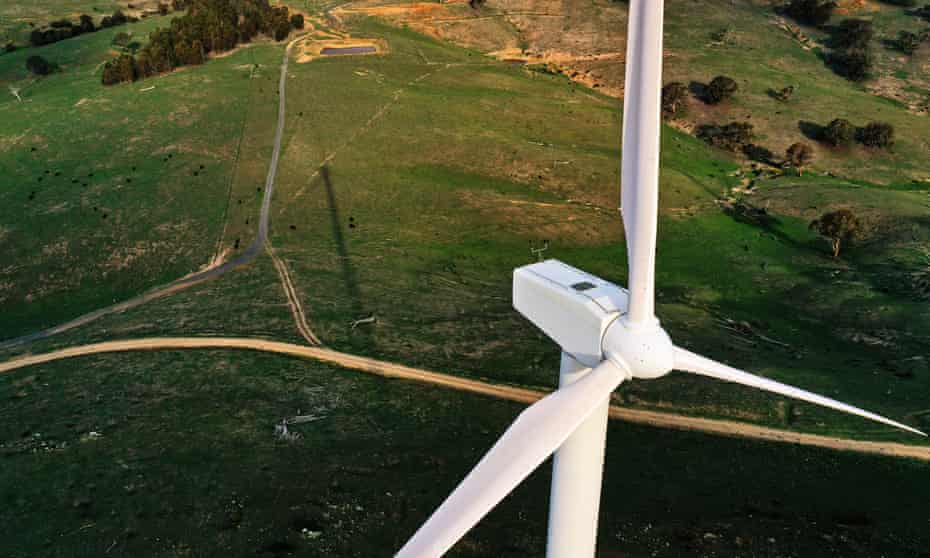States put Australia on track to beat 2030 emissions pledge but Morrison may not make it official
Prime minister under pressure to increase country’s 2030 emissions reduction goal but faces challenges from openly hostile Nationals

Last modified on Wed 13 Oct 2021 12.33 EDT
State government commitments for 2030 have put Australia within reach of meeting global expectations on tackling the climate crisis, but it will fall short unless the Morrison government steps up, a new analysis has found.
Guardian Australia understands prime minister Scott Morrison has told colleagues he wants to increase Australia’s existing 2030 emissions reduction target as part of his current negotiations with the Nationals about new climate policies to be unveiled ahead of the Cop26 climate summit in Glasgow.
New emissions projections to be released shortly are expected to forecast Australia will beat the current target of a 26-28% cut by 2030 compared with 2005 levels, and the prime minister wants to reflect that in a new target to be outlined ahead of Glasgow.
But with some Nationals openly hostile to signing up to a mid-century net zero commitment, and others on the fence, it is unclear whether Morrison will have the political capital to be able to take the extra step and increase the 2030 target.
Sources say Australia has raised with both the UK and US governments the idea of publicly declaring it would “overachieve” on its 2030 target without formally increasing the goal, but both allies have pressed Morrison to deliver the formal increase rather than window dressing.
The prime minister has been under increasing pressure from the investment and business community to commit to cutting emissions by about 50% by 2030, in line with scientific advice and goals set by major developed nations ahead of Glasgow.
The roadmap outlining Australia’s transition to net zero was discussed by cabinet for the first time on Wednesday afternoon. Ahead of that deliberation, sceptical Nationals asked Angus Taylor, the minister for energy and emissions reduction, to supply all the assumptions underpinning Treasury modelling informing the roadmap, not just the top-line findings.
Some Nationals remain implacably opposed to adopting net zero, and the junior Coalition partner will demand new commitments to revitalise regional Australia and boost employment in return for supporting any shift in climate policy.
The increasingly assertive demands from senior Nationals as the policy deliberation moves to crunch point are annoying a number of Liberal MPs who have raised objections with Morrison’s office, the treasurer, Josh Frydenberg, and Taylor.
Liberals have been advised to desist from provoking the Nationals. But some government MPs are concerned that Morrison will make oversized commitments to regional Australia in order to get the Nationals on board with a more respectable climate plan ahead of Glasgow – to the detriment of resourcing urban areas.
States create ‘chance to capitalise’
The Coalition’s rolling deliberation comes as a new report by ClimateWorks Australia, a thinktank connected to Monash University, found promised state and territory action had set de facto national targets for 2030 equivalent to a 37-42% emissions cut, 55% of electricity coming from renewable energy and at least 30% of new cars sold being electric.
The Morrison government’s climate commitments for this decade are less ambitious. It has stuck with the 26-28% emissions reduction commitment made by Tony Abbott six years ago and does not have targets for renewable energy or electric vehicle growth.
A separate report by business, union and environment groups to be released on Thursday assesses the benefits of Australia moving rapidly to build clean energy exports and finds they could surpass existing revenue from fossil fuels by 2040 and create nearly 400,000 new jobs.
ClimateWorks’ Rupert Posner said states and territories had allocated billions of dollars to emissions reduction measures and made “significant and inventive” regulatory and legislative changes since the start of 2020.
Commitments for 2030 included emissions cuts of about 50% in New South Wales, Victoria and South Australia and a goal of 50% of new car sales being electric in NSW and Victoria. The report said by July this year there was more than 10GW of new renewable energy generation and 1.4GW of new storage capacity in the pipeline.
Posner said the state action did not add up to Australia playing its part in limiting global heating to 1.5C above pre-industrial levels – a goal referenced in the Paris agreement – but showed it could.
“This provides the building blocks to deliver the change that’s necessary,” he said. “[The states] have built important momentum and their current 2030 targets will get us about halfway there. The country now has the chance to capitalise on this.”
A detailed ClimateWorks report last year found Australia could reach net zero emissions by 2035 using technologies that were “mostly already mature and available”.
‘The window is closing’: clean exports call
A separate report released jointly on Wednesday by the Australian Conservation Foundation, the Business Council of Australia, WWF and the ACTU suggested investment in clean exports could generate $89bn in new trade by 2040, surpassing that from fossil fuels, which would shrink as the world moved towards zero emissions.
The analysis – commissioned by the groups from the consultancy Accenture – found it could create 395,000 jobs in renewable hydrogen and ammonia, green metals, critical minerals, battery manufacturing, education and training and related services.
It called for coordinated national investment in seven clean export precincts across the country and the creation of a $5bn fund for workers and regions dependent on carbon-intensive industries to be run by a new “energy transition authority”.
Quick GuideHow to get the latest news from Guardian AustraliaShow

Email: sign up for our daily morning briefing newsletter
App: download the free app and never miss the biggest stories, or get our weekend edition for a curated selection of the week’s best stories
Social: follow us on YouTube, Facebook, Instagram, Twitter or TikTok
Podcast: listen to our daily episodes on Apple Podcasts, Spotify or search “Full Story” in your favourite app
The groups called for an interim target of 6GW of hydrogen and three “green metal plants” – making steel and aluminium – to be built by 2027. It urged governments to require major infrastructure projects to use low carbon materials.
Kelly O’Shanassy, the chief executive of the conservation foundation, said the report showed Australia could more than replace the revenue and jobs from coal and gas with clean exports.
The ACTU president, Michele O’Neil, said leadership was needed from the federal government to develop a national clean exports strategy. “It is not a choice between jobs and the environment, it’s a responsibility to act on both,” she said.
Martijn Wilder, the president of WWF Australia, said federal and state governments needed to work together with the private sector. “We can’t afford to squander this once in a century opportunity,” he said. “The window is closing because Australia is being outspent by other nations.”
